Adventure
A Short Walk
-John Eickert
I watched the small bird flit about in the winter naked shrub, the ruddy colored bird chirped and fluttered, absorbed in the day. I had a short time to go for
a walk and get back to work. Our winter has brought plenty of fog and rain, an overall dreary condition. Boots on, soon out through the gate and up the muddy road. The fog confined the visibility to one elephant length.
My thoughts as I stroll, feet squishing in the damp, soft road, rain pattering down on my hat and hood, stray to a morning in Manas and walking up on an elephant in the morning mist. Now there was no chance of such meeting
as the nearest wild elephant is 12,000 miles distant. Instead, I stop to watch an English sparrow working at an early nest in a leaf bare wild rose bush. Hard to imagine what the sparrow’s ancestors went through to nest aboard a sailing vessel during colonization
and then procreate to the point of eco-niche domination. Our home is more than five hundred miles from the coast, yet here are English sparrows, more native to London than Montana. I hope the glossy black-eyed bird enjoyed the weather and I wondered if English
sparrow’s become homesick during periods of fog. I ambled on.
A neighbor has an old rundown building on their property and as I slogged passed, I heard the pulsing sound of wings. Somewhere, overhead, pigeons flexed muscles, which drove feathered wings on their midwinter outing. Pigeons
found Montana in the same means and time as the English sparrow. How many winged above? I reached the end of the lane and turned back for home. The fog remained thick and the mountains, which are our neighbors, only existed in memory beyond the gloom. Watching
the mud because there was little else to see, I spied a tiny set of footprints, later my animal track guide revealed these were the tracks of a meadow vole. Voles hibernate in winter; they sleep with lower respiratory rate until genetic instinct wakes them
in time for spring. This little creature was awake about two months early. I wake up sometimes at night if I am hungry or too warm, so it would look as if the same for this small meadow creature.
Adventure ended; with great care, I removed my boots before I could soil our nest. I returned to work feeling refreshed from my exciting activity and my chance to share the world with other living
things. Too often, we think of adventure as taking place far from home in some dangerous and exotic locale in pursuit of a lofty goal or ambition. Adventure is all around, more a state of mind, a yearning for the unusual, the different, and a respite from
our daily calendar. My walk in the fog convinced me that nature’s other creatures take breaks as they further their lives. I vow to remember my lesson taught by the winter day. Cheers.
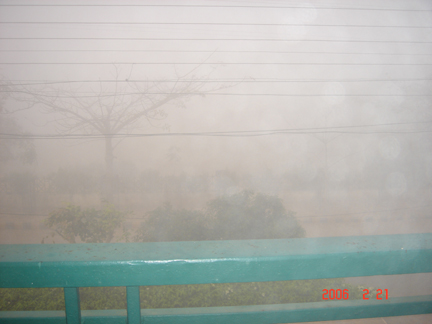
( Photo: Fog In Gurgaon Winter 2006-Susan Sharma)
|
Burning Issues
Minting Energy
-Shivani Thakur
Climate change and global warming have been hot debating points for the past few months. All over the world countries have seen extremities in weather. Heavy rains,
heatwaves, droughts in rain fed regions, less snowfall in the Alps, shrinking Arctic, receeding glaciers, breakages in polar ice-caps are proof of this freaky weather. Cheerapunji in Assam holds the spot for being the wettest region in the world. Yet last
year, even it witnessed the effects of global warming.
An increased amount of carbon dioxide (CO 2) in the atmosphere enhances the greenhouse effect contributing to global warming. The carbon dioxide levels in
the Pre-industrial era were mainly from respiration by living beings, volcanic eruptions, decomposition and forest fires. But CO2 concentrations increased after the industrial revolution in mid 1800’s when large quantities of fossil fuels (coal, petroleum)
were burnt. Aside from this deforestation, intense animal agriculture (resulting in methane gas) is a part conspirator. Scientists have laid the sole blame on climate changes on humans.
The United Nations Intergovernmental Panel on Climate Change (IPCC) has clearly stated that the effects of global warming will be seen for along time. Although there
is an explanation on how and why the planet is warming, there is nothing mentioned on what to do about it.
Though India’s contribution to air pollution is miniscule as compared to US or China, India has the potential to bring down the scale further by its
vast sources of renewable energy. Sun, wind, water nuclear energy are some of the cleanest .The only drawback is that they are expensive. Hydropower, ,at present, provides 32,326 MW of energy whereas it has the capability of supplying 1,50,000MW. A lot
of delays in the upcoming projects and inadequate transmission have hampered its growth.
Wind, at present, provides 5,300MW with the potential for 45,000 MW. Suzlon Energy is the world’s fifth largest wind turbine manufacturer. Its Dhule wind park
will produce 1000MW once compeleted. Similarly nano technology for photovoltaic cells in solar panels, binary plant technology at hot spring sites can all contribute towards much needed alternate energy. India has the world’s third largest resource of thorium,
which is used for nuclearenergy. Advanced nuclear reactors using thorium can increase nuclear power capacity from 3,360 MW to 50.00 MW.
Besides the above, afforestation and conservation of our natural resources can all help save our environment and in turn save our earth. Otherwise we will all witness extreme temperature
variations like we have seen in the past couple of years. We have flowers blooming in late January as an onset of spring, massive hailstorms in Gurgaon and sudden dip in temperature in February due to massive snowfall in upper Himalayan belt. If this doesn’t
wake us up of our slumber then what will?
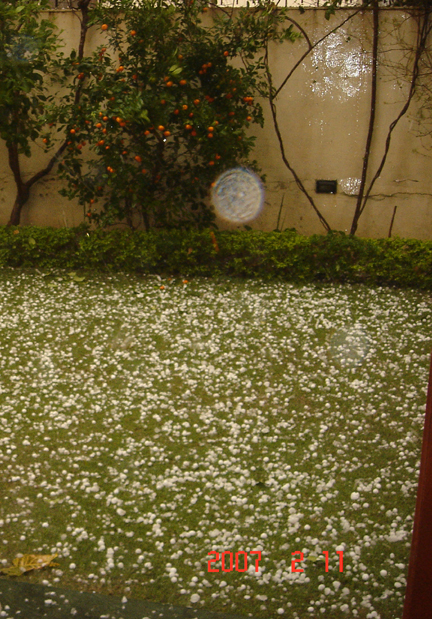
(Hailstorm in Gurgaon Winter 2007, Photo: Ashita Thomas)
|
Common Birds of India
Drongo. Dicrurus adsimilis.
-Ragoo Rao
 This month I have the Drongo for the Common Birds column. The Drongos being most active during this part of the
year, they attract a lot of attention even in the urban areas. This season they come out of their strictly wooded areas into the avenue trees also. One can see them early in the mornings and at twilight perching on medium sized tree- tops, looking around
for air-borne insects to catch them mid-air. This month I have the Drongo for the Common Birds column. The Drongos being most active during this part of the
year, they attract a lot of attention even in the urban areas. This season they come out of their strictly wooded areas into the avenue trees also. One can see them early in the mornings and at twilight perching on medium sized tree- tops, looking around
for air-borne insects to catch them mid-air.
A black bird slightly larger than a bulbul with jet black shining feathers and a long forked tail, sitting on tree
tops and scanning the surrounding for airborne insects is the Drongo or King crow as it is fondly called.
Drongos are mostly found in pairs or sometimes in a flock of upto five birds. Early mornings and late evenings are
their favorite time for foraging and it is really a sight to see their acrobatics in their effort to catch the air-borne insects.
In the cultivated fields, whenever trash is burnt you find the drongos waiting on tree tops to catch the insects flushed
out by the fire. Even shrub fires and grassland fires are sure to bring in a lot of drongos for the opportune feast of insects. 
Distribution is throughout the country. Their almost shikra like calls are a sure sign of a drongo's presence. All
one has to do is look for tree tops where they perch in a position to scan the surroundings. The drongo has also been noticed to like some flower nectar, but they have their favorite blooms.
The nesting season of the drongo is April to August that is in the prime cultivation period of rural areas when the
insect population is also good. The nest is a cup shaped one made of twigs and cobwebs, very similar to that of a bulbul' s nest. For nesting, drongos prefer medium sized trees about 15 to 20 feet from the ground. Four to five whitish brown eggs with red
spots are laid and both parents share all domestic chores. When incubation is going on it is common to find one mate sitting close by acting as a sentry. They are very bold birds and dive bomb any intruders on the ground. Even cats are scared off in this
manner.
A beautiful bird which is a marvel to watch foraging is abundant now, but the fear of dwindling is always there
with the way deforestation is being done. Drongos prefer lone trees standing in the midst of cultivated fields and we have to see that their nesting sites are not decimated or we will lose a marvelous inhabitant of our planet.
|
Eco-travel
- Susan Sharma
Just like Maharashtra has a national park right next to its capital Mumbai, Jammu and Kashmir has a national park within Srinagar, just a couple of km from the heart of Srinagar. Dachigam is famous for protecting the last few numbers of Hangul deer in the wild.
Seeing a wild hangul was on top of my list when I visited Srinagar in August 2006.
August 15, Independence Day, was just a day away. The Indian Army was out patrolling, with an armed gunman at almost every 100 meters or so. Going to Dachigam meant organizing passes and special permissions, which the owner of the houseboat we stayed in gracefully
organized. So we set off to see hangul and black bear both of which are famous residents of the Park. Just as we entered the park we saw a group of grey langurs, again endemic to this forest jumping about in the trees. On closer look these langurs did look
different from the langurs we see in Delhi; much bigger and indeed, grey. I was happy that no one including the forest guard and the army person who accompanied us objected to my using the video camera.
Next stop was an enclosure where the forest officials had rescued a baby black bear whose mother had been killed (probably by angry villagers whose crops the bear raid often). This small fellow was trying eat rotis and drink milk provided in a pan. I could
have taken a photo but did not. Somehow the idea of photographing a deprived baby black bear in a cage right inside a national park did not appeal to me. (My camera bag refused to open for the leopards caged inside the Sanjay Gandhi National Park, Mumbai too).
Suddenly we were told to keep away all cameras as we were entering a high security zone- permission to enter this area was difficult to obtain-Mr. Chapri our host informed us. Our group consisted of my husband, son and a French couple. ALL OF US WERE CURIOUS-MAY
BE WE ARE GOING TO SEE THE PROTECTED HANGUL FINALLY! Our ‘Qualis’ entered a huge gate to reveal a beautifully maintained villa and park-the winter residence of the erstwhile Prime Ministers of India. We were told this was the private house to which Indira
Gandhi retreated when she wanted privacy. The outside of the building was paneled with oak tree logs. The garden had huge trees. A very peaceful place –right inside the Dachigam National Park!
What about the hanguls we asked. The forest guard replied that one has to climb up to much higher altitudes to see them and all those areas are now out of bounds thanks to militancy. He assured us that in higher altitudes there were black bears and Himalayan
Monals in plenty- but the area is infested with militants and none is allowed to go trekking.
I had seen a documentary on the demilitarized zone of South and North Korea. The film showed how the DMZ protected highly endangered deer and antelope population of those areas thanks to heavy patrolling and some awareness among the army personnel who helped
feeding these animals in periods of extreme weather conditions. May be a similar miracle is happening in Dachigam too- or is that being too optimistic? Our forest guard companion was very happy to talk about his experiences. He was a dedicated man –dedicated
to saving the black bear in particular. He passionately believed that the Dachigam forest will survive only if the bear population is healthy and thriving. The forest belonged to them and then only to man he told us. We did see glimpses of gurgling streams
inside. The air and water inside is pure and one will never get ill if you stay inside the forest, another Kashmiri who was working with the rainbow trout project explained.
Our next stop was the rainbow trout center. Here the trout are bred scientifically and the produce sold outside at reasonable prices-one person is allowed to buy only 2 kilos in a day. The scheme is so popular, that all the produce is sold out in a couple of
hours. The trout center was well maintained. I had never seen such large trouts before. Gulmarg has a trout centre where tourists can buy coupons for fishing - again in a rationed manner- one coupon entitles you to four catches. But the rainbow trouts there
were not so big. Suddenly we were told our time inside the Park was up. We had seen all that was allowed to be seen by tourists.
I asked for some pamphlets on the Park. Our forest guard friend gave a moth eaten book produced by Sanctuary magazine for the Department of Wildlife Protection, J&K Government. It had obviously been written at a time when the Park had seen better days. I thanked
him and as was happening all too often during our trip to Kashmir, my eyes filled up, this time for the beautiful animals in a beautiful park. I could not but admire the pride and faith of the forest guard who reaffirmed my own faith that you can never subdue
nature. In that sense our visit to Dachigam had a silver lining.
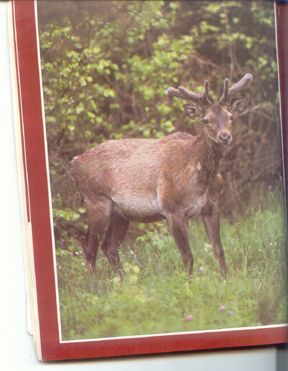 ( Hangul stag by Joanna van Gruisen taken from the Sanctuary publication) ( Hangul stag by Joanna van Gruisen taken from the Sanctuary publication)
More photographs of nature/wildlife in Kashmir
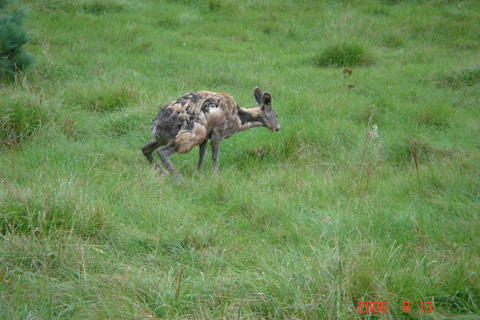
Female musk deer in a deer sanctuary on the way to Aaaroo
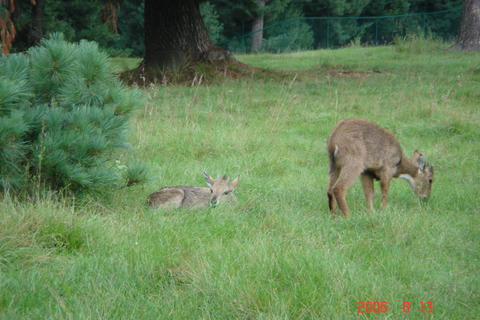
Ghorals in the sanctuary
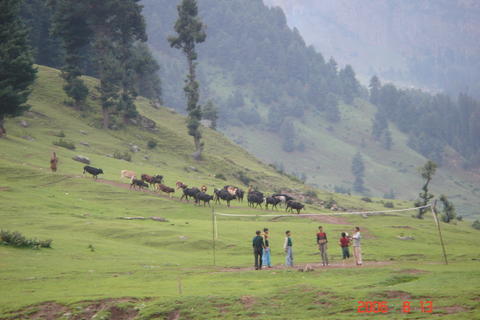
Gulmarg slopes
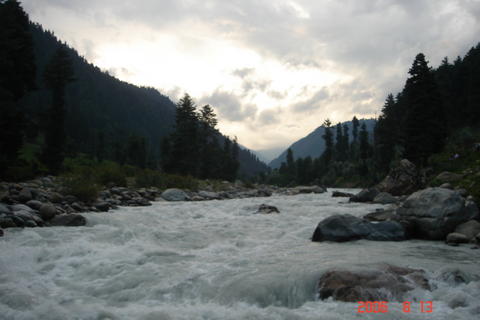
Lidder River which runs through Kashmir
|
News and Views
News…….
S.Ananthanarayanan, author of many articles on natural science in our ezine has won an Award from the department of Science and Technology for “Outstanding Effort in Science and Technology Communication in the print medium” . He has been writing the “Simple
Science” Series in Indian Express” Mumbai edition. He is also the author of a book on Great Indian Scientists. Congratulations Anantha! 
You can read the various articles Anantha wrote for Wildbytes by clicking on their titles.
Rhythm lightens the load (01 December 2006)
The rose by another name….. (01 September 2006)
Flowers and pollinators (01 August 2006)
Blood component helps insect float. (01 July 2006)
Plucky parasite
(01 April 2006)
Mask and Mime in the Jungle
(01 March 2006)
Photo film does the comeback (01 February 2006)
Getting bedeviled by ants (01 November 2005)
…..and Views
http://www.indianwildlifeclub.com/Blog/Blogs.aspx
|
Understand The Animals
FIRST SNAKE!
- Col. Ashwin Baindur
*
My first Monday morning in Binnaguri, Duars, North Bengal. At eight o’çlock after
breakfast, I opened the door to find my sahayak waiting to inform me that Chamkaur
Singh, the Mess Havaldar had caught a snake and brought it to show me.
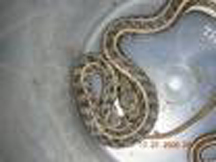 Remembering that the last time he brought me ‘ek madi-si saanp’ and poured it on the
floor from a ‘matka’, it had turned out to be a saw-scaled viper, I was hesitant. Chamkaur
appeared, pleased that he had got a second snake for the nature loving CO sahab, and
promptly flipped a plastic bottle thereby forcing me to grab onto a thin beautiful Remembering that the last time he brought me ‘ek madi-si saanp’ and poured it on the
floor from a ‘matka’, it had turned out to be a saw-scaled viper, I was hesitant. Chamkaur
appeared, pleased that he had got a second snake for the nature loving CO sahab, and
promptly flipped a plastic bottle thereby forcing me to grab onto a thin beautiful
sinuously sliding beauty. Juggling it from hand to hand till I got a grip behind its neck, I went and fetched my snake books. I use the dependable
Book of Indian Reptiles and Amphibians by J.C. Daniels and the ubiquitous
Common Indian Snakes - A Field Guide by India’s snakeman - Romulus Whitaker. These faithful buddies promptly informed that the snake in my hand was a
Buff-striped Keelback with scientific name
Amphiesma stolata (Linnaeus),
that it was gentle, ate frogs and was totally harmless.
The Buff-striped keelback had been feeding on a struggling frog when the Mess Havaldar gleefully pounced on him/her and before he knew it he was deprived of a meal,
entrapped in a pearl-pet bottle and being stared at by an incredulous mess-waiter who promptly claimed it to be a cobra! Naturally the CO sahab had to handle the snake and force a number of reluctant people to touch what they considered to be the most poisonous
snake they had seen in their lives while their compatriots thoroughly enjoyed their discomfort. This the Mess Staff considered as justified payment for fulfilling one of CO sahib’s ‘khwahish’.
The Buff-striped Keelback is a gentle and beautiful snake, which is found across India upto 2000 feet and is usually found along river banks, marshy areas and wetlands.
Binnaguri in the monsoon with its heavy rainfall, lush vegetation and many standing pools is typical buffstriped keelback country. The keelback is usually olivaceous
brown but our snake was grayish. The keelback has irregular crossbars on the body; our snake had prominent crossbars with beautiful golden spots on each side of bar. The two buff-coloured stripes along the sides are the distinctive feature of this snake. The
head has beautiful yellow on its sides and tapers to form a distinctive neck. There were black vertical markings in front and behind the large eyes with round pupils. The body has a long slender tail, which is almost a quarter of its length.
Our snake, true to its reputation, twisted and struggled but never attempted to bite. I took great care to hold the struggling snake without squeezing it too hard. We
then placed it on a paper and measured the struggling snake and found which was around 52 cms long. Normally striped keelbacks grow to 62 cms or so and the record is 90 cms. Next I asked
Chamkaur Singh to take a snap but soon realized that he was not capable of doing it. I called some officers to help me. Capt Abhishek held the snake and also photo-graphed me holding it. 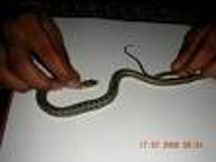
Later Capt Meghna came and gingerly handled the snake despite her fear of snakes from childhood. The snake was returned to its bottle for safe transport to the wild.
Alarmed, it inflated its body so that it was jammed against the sides of the bottle. This inflation gave delicious thrills to the peering Mess staff even more. In some cases the head even widens to provide a narrow hood. At such times, this totally harmless
and non-poisonous snake is mistaken by unknowing people to be a baby cobra and killed.
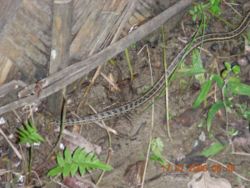 Realising that it was high time we set it free, I stirred the snake with a twig and
inverted the bottle onto the ground. It formed a beautiful sight but before I could
photograph it, the keelback sinuously reached the end of the garden. A quick snap-shot managed to catch it just before it disappeared back in the wild. It was truly a wonderful first record for me from Binnaguri! Realising that it was high time we set it free, I stirred the snake with a twig and
inverted the bottle onto the ground. It formed a beautiful sight but before I could
photograph it, the keelback sinuously reached the end of the garden. A quick snap-shot managed to catch it just before it disappeared back in the wild. It was truly a wonderful first record for me from Binnaguri!
( Text and photos Lt. Col. Ashwin Baindur,
Col at Indian Army commanding an Engineer Regiment
at Indian Army)
|
Zoo
Waste Water to Irrigate Parks and Gardens
-Ajit Seshadri
When cities face shortage of water supply, while domestic supply is sustained, the horticultural needs are not met. As a result public parks and gardens remain parched.
In such an urban scenario, while the dirty drains flow with waste water, parks are devoid of water for irrigation. Vigyan Vijay Foundation (VVF) an NGO from New Delhi has
implemented a plan to source dirty water and optimally process and make it fairly clean for watering the nearby parks.
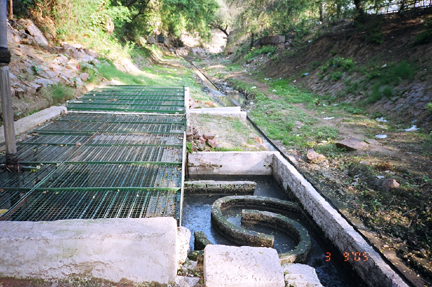
The initiative was taken by the Vasant Vihar Resident Association way back in 2002, when they started raising funds for the project. A pilot plant with the technical
support of VVF yielded less than optimum quality water and more tests followed. In 2005, a Water treatment plant with a capacity of 35 kilo litres of water per day was completed at a total cost of Rs 7 lakhs. The recycled water is led to irrigate about
12 acres of public parks in residential areas.
The decentralized Waste Water Treatment System uses bio-settlers and filters like stones, plants, coconut kernel fibres and wood coal to treat drain water from the area.
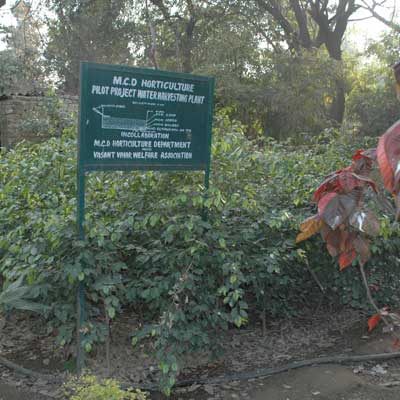 VVF have also implemented a waste water treatment plant for CSE New Building at Tughlakabad Institutional Area. VVF have also implemented a waste water treatment plant for CSE New Building at Tughlakabad Institutional Area.
Use of plants as bio remediers has lot of scope for flowing and stagnant water. We are yet to take this up on a large scale.
The Chennai Mathematical Institute, spread across five acres in Siruseri, has been using a reed bed including plants like Canna, Bannana and Yam for grey water
recycling in their premises. These plants keep the soil partially aerobic by pumping atmospheric oxygen to the roots, where some micro organisms live. These bacteria help in the break down on any suspended solids in the grey water.
The blooming flowers of Vasant Vihar Park are a reminder to all civic authorities and resident welfare associations that this is the way to go!
The author is Head, Environmental Wing at Vigyan Vijay Foundation.
|